mobile Ansicht, to the English Version tap the flag
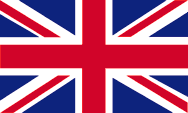

- Demokratische Republik Kongo
- präsidiale Republik
- Eigenbezeichnung: République démocratique du Congo
- frühere Namen:
1885–1908 Kongo-Freistaat
1908–1960 Belgisch-Kongo
1960–1966 Kongo-Léopoldville
1966–1971 Kongo-Kinshasa
1971–1997 Zaire
• Flagge
• historische Flaggen
• regionale Flaggen
– Katanga
– Süd-Kasai
• Bedeutung/Ursprung der Flagge
• Wappen
• Bedeutung/Ursprung des Wappens
• Flugzeugkokarde
• Landkarte
• Zahlen und Fakten
• Geschichte
• Ursprung des Landesnamens
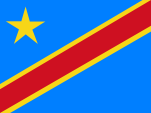
seit 2006,
Nationalflagge,
Seitenverhältnis = 3:4,
Quelle: Wikipedia (D)






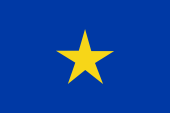
1877–1908,
Nationalflagge des Kongo-Freistaats




1908–1960,
Nationalflagge von Belgisch-Kongo



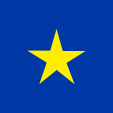
1908–ca.1950(?),
Standarte des Generalgouverneurs von Belgisch-Kongo,
Quelle, nach: Bulgaria Bildband Fahnenbilder



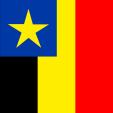
ca.1950(?)–1960,
Standarte des Generalgouverneurs von Belgisch-Kongo,
Quelle, nach: Flags of the World



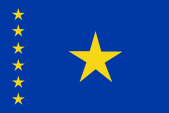
1960–1963,
Nationalflagge,
Seitenverhältnis = 2:3,
Quelle, nach: Wikipedia (D)





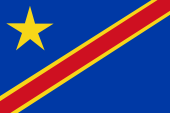
1963–1966,
Nationalflagge,
Seitenverhältnis = 2:3,
Quelle, nach: Wikipedia (D)



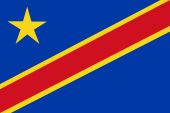
1966–1971,
Nationalflagge,
Seitenverhältnis = 2:3,
Quelle, nach: Wikipedia (D)



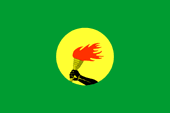
1971–1997,
Nationalflagge,
Seitenverhältnis = 2:3,
Quelle, nach: Wikipedia (D)




1997–2003,
Nationalflagge,
Seitenverhältnis = 2:3,
Quelle, nach: Wikipedia (D)





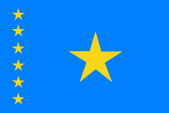
2003–2006,
Nationalflagge,
Seitenverhältnis = 2:3,
Quelle, nach: Wikipedia (D)




Die heutige Flagge von Kongo-Kinshasa wurde am 18.02.2006 eingeführt. Eine ähnliche Flagge war bereits zwischen dem 1963 und 1971 in Gebrauch. Die Flagge besteht aus einem hellblauem Flaggentuch mit einem gelben fünfzackigen Stern in der Oberecke und einen roten, gelb geränderten Diagonalstreifen. Als Farbwerte für die Flagge werden angegeben: Hellblau = Pantone 299, Rot = Pantone 186, Gelb = Pantone 107. Die Farbe Blau soll für den Frieden unter den Völkern des Kongo stehen, das Rot für das Blut der im Kampf um die Freiheit gefallenen Kämpfer, das Gold steht für Wohlstand. Der Stern symbolisiert die Einheit des Landes und der Diagonalstreifen die Zukunft. Die Flagge des Kongo Freistaates, die bereits im Jahre 1877 angeblich von Henry Morton Stanley geschaffen wurde, war blau mit einem großen gelben Stern in der Mitte. Sie wurde auch während der belgischen Kolonialzeit beibehalten. Bei Erlangung der Unabhängigkeit am 30. September 1960 wurden auf der bisherigen Flagge sechs kleine gelbe Sterne für die Provinzen am Flaggenmast hinzugefügt. So zeigte die Flagge damals ein blaues Flaggentuch mit einem großen gelben fünfzackigen Stern in der Mitte und sechs kleineren gelben fünfzackigen Sterne am Flaggenmast. Der große gelbe Stern steht für die Nation und die kleinen Sterne für die damaligen sechs Provinzen. Das Blau symbolisierte damals den Himmel über dem Land und das Gelb die Bodenschätze des Landes. Diese Flagge war bis zum 30.06.1963 in Gebrauch, wurde aber nach der Zaire-Ära (1971–1997) erneut eingeführt und bis 2003 verwendet und in Hellblau noch einmal bis 2006. Da zwischen den Jahren 1960 und 1963 zwei Provinzen den Staat Kongo verlassen hatten, hätte man in dieser Zeit zwei Sterne von der bisherigen Flagge entfernen müssen. Um solchen Tendenzen vorzubeugen, und auch um die Rolle der Provinzen in den Hintergrund zu drängen, wurde eine völlig neue Flagge geschaffen. Diese neue Flagge wurde am 01.07.1963 angenommen, und 1966 ein klein wenig verändert. Das Flaggentuch zeigte wieder ein dunkles Blau und nur einen einzigen gelben Stern in der Oberecke am Mast und einem roten, gelb geränderten Diagonalstreifen. Diese Flagge wurde zur Vorlage für jene Flagge, die 2006 in Hellblau eingeführt wurde. Zunächst aber trat am 24. November 1971 eine grüne Flagge mit einer goldenen Scheibe an deren Stelle, darauf ein brauner Arm, der eine braune Fackel mit roter Flamme hält. Sie wurde im Zusammenhang mit der Umbenennung des Landes in "Zaire" angenommen. Arm und Fackel symbolisieren den revolutionären Geist der Nation, die rote Flamme ehrt die Märtyrer des Unabhängigkeitskampfes. Grün ist Symbol der Zukunftshoffnung. Diese Flagge basierte auf der Parteiflagge der MPR (Mouvement Populaire de la Revolution), enthielt aber auch die panafrikanischen Farben Rot, Gelb und Grün (siehe → Äthiopien).
Quelle:
Wikipedia (D),
Wikipedia (EN),
Die Welt im bunten Flaggenbild,
Flaggen Wappen Hymnen,
Die Welt der Flaggen


1885–1908,
Wappen des Kongo-Freistaats,
Quelle: Wikipedia (FR)
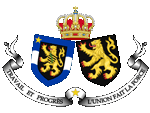
1908–1960,
Wappen von Belgisch-Kongo,
Quelle: Lesser coat of arms of Belgium.svg: Katepanomegas und Sodacan gemeinsam; Schild Kongo Freistaat.svg: MS05L.MS05L at de.wikipedia [CC BY-SA 3.0], via Wikimedia Commons

1960–1963,
Wappen von Kongo-Léopoldville,
Quelle: MS05L [CC BY-SA 3.0], via Wikimedia Commons

1963–1971,
Wappen von Kongo-Kinshasa,
Quelle: Coats_of_arms_of_Zaire_1971-1997.svg: Tadpole9derivative work: MS05L [Public domain], via Wikimedia Commons
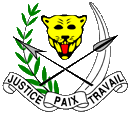
1971–1997,
Wappen von Zaire,
Quelle: Corel Draw 4

1997–1999,
Wappen von Kongo-Kinshasa,
Quelle: Coats_of_arms_of_Zaire_1971-1997.svg: Tadpole9derivative work: MS05L [Public domain], via Wikimedia Commons

1999–2003,
Wappen von Kongo-Kinshasa,
Quelle: via Wikimedia Commons

2003–2006,
Wappen von Kongo-Kinshasa,
Quelle: via Wikimedia Commons
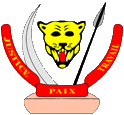
seit 2006,
Wappen von Kongo-Kinshasa,
Quelle: Wikipedia (EN)

Am 18.02.2006 wurde das heutige Wappen eingeführt. Es zeigt wieder den bis 1997 verwendeten Leopardenkopf, begleitet von einem Elefantenstoßzahn und einem Speer. Auf einem Sockel ein Spruchband mit dem Motto des Landes: "Justice, Paix, Travail" → "Gerichtsbarkeit, Frieden, Arbeit". Das Wappen von Zaire zeigte den Kopf eines Leoparden, der von einem Palmenzweig und einem Elefantenstoßzahn umgeben war. Im Vordergrund kreuzten sich ein Pfeil und ein Speer. Unterhalb ein Spruchband mit dem Motto des Landes: "Justice, Paix, Travail" → "Gerichtsbarkeit, Frieden, Arbeit".
Quelle:
Wikipedia (D)

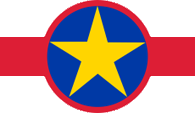
seit 1997,
Flugzeugkokarde,
Quelle, nach: Wikipedia (EN)
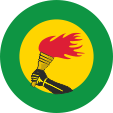
1992–1997,
Flugzeugkokarde,
Zaire,
Quelle, nach: Wikipedia (EN)

Lage:
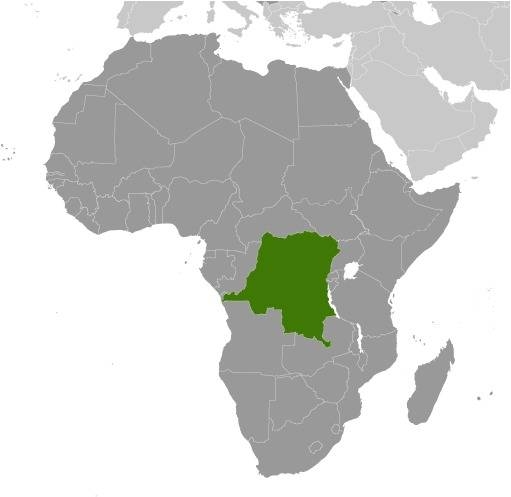
Quelle: CIA World Factbook
Landkarte des Landes:
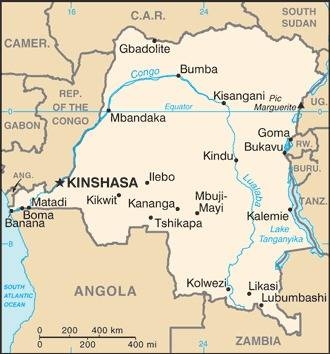
Quelle: CIA World Factbook

Fläche: 2.344.858 km²
Einwohner: 5.546.307 (2022), davon 18% Luba (Bantu), 16% Kongo (Bantu), 13% Mongo (Bantu), 10% Ruanda (Bantu), Azande, Bangi, Ngale, Niloten, Pygmäen und Hima
Religionen: 50% Katholiken, 20% Protestanten, 10% andere Christen, 10% Moslems, 10% Animisten
Bevölkerungsdichte: 39 Ew./km²
Hauptstadt: Kinshasa (bis 1966 Léopoldville), 14.970.000 Ew. (2021)
Amtssprache: Französisch
sonstige Sprachen: Tschiluba, Kongo, Lingala, Suaheli
Währung: 1 Kongo-Franc (CDF, FC) = 100 Centimes
Zeitzone: MEZ bis MEZ +1 h
Quelle:
Wikipedia (D)

15. Jhd. bis 19. Jhd. · Kongoreich im Westen, Lubareich und Lundareich in der Mitte des heutigen Kongo-Kinshasa
18. Jhd. bis 19. Jhd. · Kubareich in der Mitte des heutigen Kongo-Kinshasa
19. Jhd. · Kassongo-Reich im Osten des heutigen Kongo-Kinshasa, der arabische Einfluss dehnt sich von Osten kommend bis an den Kongo-Fluss aus
1876 · der Forscher Henry Morton Stanley beginnt große Ländereien im Kongobecken für König Leopold II. von Belgien zu erwerben
1884–1885 · Berliner Kongokonferenz, Anerkennung der Besitzungen Leopolds II. als Kongo-Freistaat durch die europäischen Mächte
1891 · Katanga kommt zum Kongo-Freistaat
1908 · Auflösung des Kongo-Freistaats, Errichtung der unmittelbaren belgischen Kolonialverwaltung, Umbenennung in Belgisch-Kongo
1920 · die Territorien Ruanda und Urundi, Teile des ehemaligen Deutsch-Ostafrika, werden gemäß dem Versailler Diktat als Mandat des Völkerbundes der Kolonie Belgisch-Kongo angeschlossen
30.06.1960 · Unabhängigkeit als Republik Kongo für das frühere Belgisch-Kongo, wenig später Armeerevolte, die Provinzen Katanga und Kasai erklären sich für unabhängig, Bürgerkrieg bis 1965
1961 · Umbenennung in Bundesrepublik Kongo
1962 · der Staat Kasai kapituliert
1963 · UN-Truppen erobern den Staat Katanga
1964 · Abzug der UN-Truppen, Umbenennung in Demokratische Republik Kongo
25.11.1965 · General Joseph-Désiré Mobutu putscht sich an die Macht
1966 · Umbenennung vieler Städte mit europäischen Namen (z.B. Stanleyville in Kisangani)
1967 · Gründung der Einheitspartei „Revolutionäre Volksbewegung“ (MPR), neue Verfassung, Ein-Parteien-System
23.10.1971 · Umbenennung des Landes von Kongo in Republik Zaire, Umbenennung von Katanga in Shaba
1977 · katangische Rebellen fallen von Angola aus nach Shaba (Katanga) ein
1978 · katangische Rebellen fallen erneut von Angola aus nach Shaba (Katanga) ein
1991 · soziale Unruhen, Einführung des Mehr-Parteien-Systems
1993 · Gouverneur Gabriel Kyungu Wa Kumwanza veranlasst offiziell die Rückbenennung der Provinz in Katanga, und erklärt diese für autonom
1996 · Kämpfe zwischen Hutu und Tutsi, Beginn des Bürgerkrieges gegen Mobutu
1997 · Sturz des Joseph-Désiré Mobutu durch Militär und Stammesmilizen, Mobutu geht ins Exil nach Frankreich und stirbt, neuer Staatschef wird Laurent Désiré Kabila, Umbenennung des Landes von Zaire in Kongo (Demokratische Republik), die Tutsi-Milizen wenden sich gegen Kabila
30.06.1998 · Einführung des Kongolesischen Franc
02.08.1998 · Tutsi-Milizen und Truppen aus Ruanda und Uganda beginnen ein bis heute anhaltenden offenen Krieg gegen die Zentralregierung
16.01.2001 · Präsident Laurent Desiré Kabila wird ermordet, Nachfolger wird sein Sohn Joseph Kabila
2015 · Katanga wird auf Beschluss des Präsidenten von Kongo-Kinshasa aufgelöst und in vier einzelne Provinzen aufgeteilt (Haut-Katanga, Haut-Lomami, Lualaba, Tanganyika) und per Gesetz zur Neuregelung der Provinzen umgesetzt
2019 · Joseph Kabila wird abgewählt
Quelle:
Atlas zur Geschichte,
Wikipedia (D),
Discovery '97,
Weltgeschichte,
Länder der Erde

"Kong" heißt in der Sprache der Bantu "Berg". Offenbar wurde der Name "Berg" durch die Einheimischen auf einen ganzen Fluss übertragen, der seine Quelle tatsächlich in den Bergen hat. Offiziell werden die beiden Kongos gerne durch den Zusatz "Republik" oder "Demokratische Republik" unterschieden. Das ist wenig zweckmäßig, da sich solche Bezeichnungen sehr schnell ändern können und außerdem nicht die staatsrechtlichen Realitäten wiedergegeben werden. Die Regelung die beiden Kongos durch den Anhang des Namens der Hauptstadt auseinanderzuhalten ist weit verbreitet, weitaus zweckmäßiger und hat sich in der Vergangenheit bewährt.
Die Bezeichnung "Zaire" war keine Wortschöpfung von Mobutu, sondern Mobutu hatte auf eine alte – bei den Bantu im 15. Jahrhundert gebräuchliche – Bezeichnung für den Unterlauf des Flusse Kongo zurückgegriffen, um den Landesnamen authentischer und ursprünglicher erscheinen zu lassen. "Zaire" leitet sich ab aus dem Bantu-Wort "n'zadi", was "großes Wasser" heißt.
Quelle: Handbuch der geographischen Namen, Volker Preuß


![]()















































